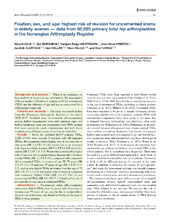| dc.contributor.author | Dale, Håvard | en_US |
| dc.contributor.author | Børsheim, Sjur | en_US |
| dc.contributor.author | Kristensen, Torbjørn | en_US |
| dc.contributor.author | Fenstad, Anne Marie | en_US |
| dc.contributor.author | Gjertsen, Jan-Erik | en_US |
| dc.contributor.author | Hallan, Geir | en_US |
| dc.contributor.author | Lie, Stein Atle | en_US |
| dc.contributor.author | Furnes, Ove | en_US |
| dc.date.accessioned | 2020-08-06T13:09:53Z | |
| dc.date.available | 2020-08-06T13:09:53Z | |
| dc.date.issued | 2020 | |
| dc.Published | Dale H, Børsheim S, Kristensen T, Fenstad F, Gjertsen JE, Hallan G, Lie SA, Furnes O. Fixation, sex and age: highest risk of revision for uncemented stems in elderly women- data from 66,995 primary total hip arthroplasties in the Norwegian arthroplasty register.. Acta Orthopaedica. 2020;91(1):33–41 | eng |
| dc.identifier.issn | 1745-3674 | |
| dc.identifier.issn | 1745-3682 | |
| dc.identifier.uri | https://hdl.handle.net/1956/23530 | |
| dc.description.abstract | Background and purpose: There is no consensus on best method of fixation in hip arthroplasty. We investigated different modes of fixation in primary total hip arthroplasty (THA) and the influence of age and sex, to assess need for a differentiated approach. Patients and methods: The study was based on data from the Norwegian Arthroplasty Register in the period 2005–2017. Included were all-cemented, all-uncemented, reverse hybrid (uncemented stem and cemented cup), and hybrid (cemented stem and uncemented cup) THA designs that were commonly used, contemporary and well documented, using different causes of revision as endpoints. Results: From the included 66,995 primary THAs, 2,242 (3.3%) were revised. Compared with all-cemented THAs, all-uncemented had a higher risk of revision due to any cause (RR 1.4; CI 1.2–1.6), mainly due to an increased risk of periprosthetic fracture (RR 5.2; CI 3.2–8.5) and dislocation (RR 2.2; CI 1.5–3.0). Women had considerably higher risk of revision due to periprosthetic fracture after all-uncemented THA (RR 12; CI 6–25), compared with cemented. All-uncemented THAs in women of age 55–75 years (RR 1.3; CI 1.0–1.7) and over 75 years of age (RR 1.8; CI 1.2–2.7), and reverse hybrid THAs in women over the age of 75 (RR 1.5; CI 1.1–1.9) had higher risk of revision compared with cemented. Hybrid THAs (RR 1.0; CI 0.9–1.2) and reverse hybrid THAs (RR 1.0; CI 0.7–1.3) had similar risk of revision due to any cause as cemented THAs. Interpretation: Uncemented stems (all-uncemented and reverse hybrid THAs) had increased risk of revision in women over 55 years of age, mainly due to periprosthetic fracture and dislocation, and should probably not be used in THA in these patients. | en_US |
| dc.language.iso | eng | eng |
| dc.publisher | Taylor & Francis | eng |
| dc.rights | Attribution CC BY | eng |
| dc.rights.uri | http://creativecommons.org/licenses/by/4.0/ | eng |
| dc.title | Fixation, sex, and age: highest risk of revision for uncemented stems in elderly women - data from 66,995 primary total hip arthroplasties in the Norwegian Arthroplasty Register | en_US |
| dc.type | Peer reviewed | |
| dc.type | Journal article | |
| dc.date.updated | 2020-01-15T16:44:49Z | |
| dc.description.version | publishedVersion | en_US |
| dc.rights.holder | Copyright 2019 The Authors | |
| dc.identifier.doi | https://doi.org/10.1080/17453674.2019.1682851 | |
| dc.identifier.cristin | 1759698 | |
| dc.source.journal | Acta Orthopaedica | |

